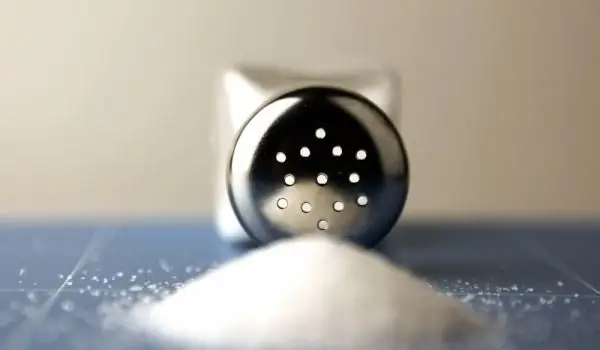2025 Author: Jasmine Walkman | [email protected]. Last modified: 2025-01-23 10:18
Sodium is an alkali metal that cannot be found alone in nature. We take it daily with the help of a number of substances - salt, soda, food preservatives and others.
Sodium is a vital element that transmits impulses and works muscles. It maintains the electrolyte balance in the body and is a regulator of the amount of fluid in the body, as the kidneys retain water to be able to dilute sodium in the body.
Sodium intake in our body it happens mainly with the amounts of salt. In small doses, it is not only an important flavoring, but also useful. The salt we use in the kitchen contains about 40 percent sodium. It is recommended to take about 2300 milligrams a day, ie 1 teaspoon of salt, but only in a healthy body. In the presence of a health problem, the amount should not exceed 1500 milligrams per day.
The average person takes at least 7,000 milligrams a day, which is a prerequisite for serious heart problems. The kidneys that are responsible for the removal of excess salt from the body, can't handle high sodium levels and its amount in the bloodstream increases. This forces the heart to work at a higher speed, and this fact leads to increased blood pressure.
The desire to eat salty is associated with a lack of calcium in the body. Sodium temporarily raises calcium levels and the body is deceived that calcium is in sufficient quantities. However, with more sodium intake, the calcium that is excreted from the body increases and the levels of calcium in the body decrease alarmingly.
How to keep sodium levels under control?

It is first necessary to realize that many foods are full of sodium, more than you realize. Salt is the best preservative, as well as a perfect flavoring. Therefore, the ability to keep it under control is not easy.
However, you can follow some simple tips to monitor sodium intake.
- Care must be taken with secret sources of salt, reading the labels carefully. Monosodium glutamate, sodium bicarbonate, sodium benzoate and sodium phosphate are serious sources. They are embedded in confectionery and spices where they are not normally expected to be present;
- The packaging often lies. The indication that the product contains less sodium often means that this lower amount is insignificant and is in fact the expected doses of sodium;
- Sodium is added to foods that have undergone processing. Therefore, the right choice are fresh products - fruits, vegetables and meat;
- Each type of salt contains equal amounts of sodium. Sea or Himalayan salt cannot be said to be less harmful. The iodized salt also contains the necessary element iodine;
- Salt should be slowly reduced as a quantity used until complete removal and replacement with herbs and spices to flavor the food.
Recommended:
Why Limit Meat Intake?

In almost every Bulgarian household, meat and meat products are revered. At the same time, most statistics show that the amount of space should be severely limited and more fresh fruits and vegetables should be eaten. And it really is. The main reason is that meat contains a lot of fat and is one of the foods that the body fails to process quickly.
How To Eat If We Want To Reduce Sugar Intake?

Many people feel the need to eat confectionery, others overindulge in sweets when they are depressed, hoping that this will make them feel better. But in this way they harm their health. Yes, sugar gives a lot of energy, but it is energy that is quickly depleted.
How To Limit Salt Intake

In Bulgaria, the issue of salt intake is becoming more and more acute. Consumption of the product is twice as high as the upper limit for safe intake, set at 5 grams per day. On average, Bulgarians consume up to 10-14 grams per day, and in some regions of the country it reaches a record 18-20 grams.
What Is The Daily Intake Of Carbohydrates

Carbohydrates are an important source of energy for the body. Their reference value for the average adult is 310 grams. Despite the generally accepted limits for the intake of carbohydrates, proteins and fats, they are most accurately determined individually, according to height, weight, physical activity.
Facts About Sodium Nitrate And Sodium Nitrite That You Need To Know

Nitrates and nitrites are chemical compounds commonly used in the manufacture of dried meat products such as bacon. A lot of ink has been spilled in discussing the idea that nitrates and nitrites are bad for us and food manufacturers are introducing all kinds of "

